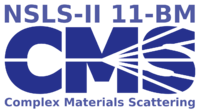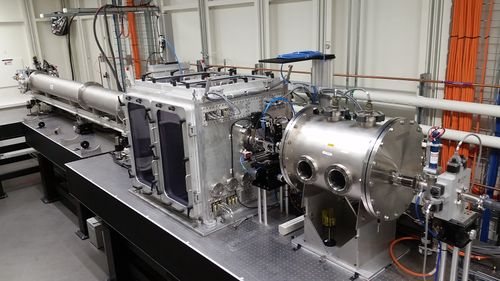Difference between revisions of "CMS"
KevinYager (talk | contribs) (→Beam Size) |
KevinYager (talk | contribs) (→Beamline Staff) |
||
| (22 intermediate revisions by 3 users not shown) | |||
| Line 1: | Line 1: | ||
[[Image:logo_CMS_20.png|thumb|200px|right]] | [[Image:logo_CMS_20.png|thumb|200px|right]] | ||
| − | The '''Complex Materials Scattering''' ('''CMS''') [[beamline]] at [[NSLS-II]] is a [[synchrotron]] instrument focused on [[x-ray]] [[scattering]]. It is located at 11-BM ([[bending magnet]] port) on the NSLS-II floor, and features a [[three-pole wiggler]] source. It can perform [[SAXS]] and [[WAXS]] experiments, focusing on high-throughput and 'intelligent' machine-guided exploration of parameter spaces. | + | The '''Complex Materials Scattering''' ('''CMS''') [[beamline]] at [[NSLS-II]] is a [[synchrotron]] instrument focused on [[x-ray]] [[scattering]]. It is located at 11-BM ([[bending magnet]] port) on the NSLS-II floor, and features a [[three-pole wiggler]] source. It can perform [[SAXS]] and [[WAXS]] experiments, focusing on ambitious synchrotron experiments, including [[in-situ]] or [[operando]] studies of materials during synthesis, processing, or operation; and autonomous experiments including high-throughput explorations and 'intelligent' machine-guided exploration of parameter spaces. |
[[Image:CMS_beamline01.jpg|thumb|500px|center]] | [[Image:CMS_beamline01.jpg|thumb|500px|center]] | ||
==Capabilities== | ==Capabilities== | ||
| − | + | CMS can perform a variety of experiments: | |
* [[SAXS]] | * [[SAXS]] | ||
* [[GISAXS]] | * [[GISAXS]] | ||
| Line 26: | Line 26: | ||
{| class="wikitable" | {| class="wikitable" | ||
|- | |- | ||
| − | ! beam size | + | ! beam size |
| − | ! beam divergence | + | ! beam divergence |
| − | ! pixel size | + | ! pixel size |
| − | ! pixel FW @ 5 m | + | ! pixel FW @ 5 m |
| − | ! pixel FW @ 5 m, 13.5 keV (Å<sup>−1</sup>) | + | ! pixel FW @ 5 m, 13.5 keV |
| − | ! | + | ! resolution |
| + | ! resolution | ||
| + | |- | ||
| + | ! (mm) | ||
| + | ! (mrad) | ||
| + | ! (mm) | ||
| + | ! (mrad) | ||
| + | ! (Å<sup>−1</sup>) | ||
| + | ! FWHM (Å<sup>−1</sup>) | ||
| + | ! σ (Å<sup>−1</sup>) | ||
|- | |- | ||
|- | |- | ||
| Line 41: | Line 50: | ||
| 0.00024 | | 0.00024 | ||
| 0.0007 | | 0.0007 | ||
| + | | 0.00030 | ||
|- | |- | ||
| 0.100 | | 0.100 | ||
| Line 48: | Line 58: | ||
| 0.00024 | | 0.00024 | ||
| 0.0002 | | 0.0002 | ||
| + | | 0.00008 | ||
|- | |- | ||
|} | |} | ||
| Line 54: | Line 65: | ||
===Flux=== | ===Flux=== | ||
| + | |||
| + | ====Full Beam==== | ||
At start of endstation (bim3 ionchamber): | At start of endstation (bim3 ionchamber): | ||
* 1.6 ×10<sup>12</sup> ph/s/0.1%bw (1.5 × 0.1 mrad; diagnostic mesh in-place; 13.5 keV, 250 mA ring current) | * 1.6 ×10<sup>12</sup> ph/s/0.1%bw (1.5 × 0.1 mrad; diagnostic mesh in-place; 13.5 keV, 250 mA ring current) | ||
| + | * 1.5 ×11<sup>11</sup> ph/s/0.1%bw (0.1 × 0.1 mrad; 13.5 keV, 250 mA ring current) | ||
Near sample position, full beam (no slits): | Near sample position, full beam (no slits): | ||
| − | * 1.3 ×10<sup>12</sup> ph/s/0.1 | + | * '''1.3 ×10<sup>12</sup> ph/s''' (13.5 keV, 250 mA ring current) |
| + | |||
| + | ====Normal Beam==== | ||
| + | For 13.5 keV, 250 mA ring current: | ||
| + | {| class="wikitable" | ||
| + | |- | ||
| + | ! S4 slits size (mm) | ||
| + | ! beam divergence (mrad) | ||
| + | ! beam size at sample position (μm) | ||
| + | ! beam flux at sample/detector (ph/s) | ||
| + | ! olog | ||
| + | |- | ||
| + | |- | ||
| + | | 1.000 H × 1.000 V | ||
| + | | 0.10 H × 0.10 V | ||
| + | | | ||
| + | | '''2.1×10<sup>11</sup>''' | ||
| + | | [https://logbook.nsls2.bnl.gov/11-BM/index.html#834_2 834_2] | ||
| + | |- | ||
| + | | 0.200 H × 0.200 V | ||
| + | | 0.10 H × 0.10 V | ||
| + | | | ||
| + | | '''1.2×10<sup>11</sup>''' | ||
| + | | [https://logbook.nsls2.bnl.gov/11-BM/index.html#834_2 834_2] | ||
| + | |- | ||
| + | | 0.100 H × 0.100 V | ||
| + | | 0.10 H × 0.10 V | ||
| + | | | ||
| + | | '''3.4×10<sup>10</sup>''' | ||
| + | | [https://logbook.nsls2.bnl.gov/11-BM/index.html#834_2 834_2] | ||
| + | |- | ||
| + | | 0.050 H × 0.050 V | ||
| + | | 0.10 H × 0.10 V | ||
| + | | | ||
| + | | '''8.6×10<sup>9</sup>''' | ||
| + | | [https://logbook.nsls2.bnl.gov/11-BM/index.html#834_2 834_2] | ||
| + | |- | ||
| + | | 0.020 H × 0.020 V | ||
| + | | 0.10 H × 0.10 V | ||
| + | | | ||
| + | | '''1.1×10<sup>9</sup>''' | ||
| + | | [https://logbook.nsls2.bnl.gov/11-BM/index.html#834_2 834_2] | ||
| + | |- | ||
| + | | 0.100 H × 0.020 V | ||
| + | | 0.10 H × 0.10 V | ||
| + | | | ||
| + | | '''5.4×10<sup>9</sup>''' | ||
| + | | [https://logbook.nsls2.bnl.gov/11-BM/index.html#834_2 834_2] | ||
| + | |- | ||
| + | | 0.100 H × 0.010 V | ||
| + | | 0.10 H × 0.10 V | ||
| + | | | ||
| + | | '''1.9×10<sup>9</sup>''' | ||
| + | | [https://logbook.nsls2.bnl.gov/11-BM/index.html#834_2 834_2] | ||
| + | |- | ||
| + | |} | ||
| + | |||
| + | For 13.5 keV, 375 mA ring current: | ||
| + | {| class="wikitable" | ||
| + | |- | ||
| + | ! S4 slits size (mm) | ||
| + | ! beam divergence (mrad) | ||
| + | ! beam size at sample position (μm) | ||
| + | ! beam flux at sample/detector (ph/s) | ||
| + | ! source | ||
| + | |- | ||
| + | |- | ||
| + | | 0.200 H × 0.050 V | ||
| + | | 0.10 H × 0.10 V | ||
| + | | | ||
| + | | '''5×10<sup>10</sup>''' | ||
| + | | Estimated | ||
| + | |- | ||
| + | |} | ||
| + | |||
| + | ====Small Beam==== | ||
| + | |||
| + | For 13.5 keV, 250 mA ring current: | ||
| + | {| class="wikitable" | ||
| + | |- | ||
| + | ! S4 slits size (mm) | ||
| + | ! beam divergence (mrad) | ||
| + | ! beam V size at sample position (μm) | ||
| + | ! beam flux at sample/detector (ph/s) | ||
| + | ! olog | ||
| + | |- | ||
| + | |- | ||
| + | |- | ||
| + | | 0.100 H × 0.010 V | ||
| + | | 0.10 H × 0.10 V | ||
| + | | 33 | ||
| + | | '''2×10<sup>9</sup>''' | ||
| + | | [https://logbook.nsls2.bnl.gov/11-BM/#819_1 819_1] | ||
| + | |- | ||
| + | | 0.100 H × 0.010 V | ||
| + | | 0.10 H × 0.05 V | ||
| + | | 22 | ||
| + | | '''1×10<sup>9</sup>''' | ||
| + | | [https://logbook.nsls2.bnl.gov/11-BM/#821_1 821_1] | ||
| + | |- | ||
| + | |} | ||
| + | |||
| + | * With divergence of 0.1 mrad H x 0.05 mrad V and S4 beam size of 0.1 mm H x 0.01 mm V, "knife-edge" smy scan implies beam FWHM of ~ 22 um V at sample and flux of 1e+9 cts/s as measured at Pilatus (with attenuation factor included). | ||
| + | |||
| + | With divergence of 0.1 mrad H x 0.1 mrad V and S4 beam size of 0.1 mm H x 0.01 mm V, "knife-edge" smy scan implies beam FWHM of ~ 33 um V at sample and flux of 2e+9 cts/s as measured at | ||
===Beam Size=== | ===Beam Size=== | ||
* Typical 50-100 µm | * Typical 50-100 µm | ||
* Beam can be shaped (using slits) to 10 µm. | * Beam can be shaped (using slits) to 10 µm. | ||
| + | |||
| + | ==Configuration== | ||
| + | CMS is a flexible SAXS/WAXS instrument. The instrument has two detectors (SAXS and WAXS) that can be repositioned as needed for experiments. The sample environment is flexible, with the ability to measure samples in vacuum or in air. | ||
| + | * [[CMS:Sample area]] | ||
| + | CMS can accommodate a wide range of sample holders and customized ([[in-situ]] or operando) sample environments. | ||
| + | * [[CMS:Sample environments]] | ||
==Access== | ==Access== | ||
| − | CMS | + | CMS is available for general user experiments. Proposals can be submitted through the [http://www0.bnl.gov/ps/PASS/ NSLS-II proposal system], and through the [[CFN]] [https://www.bnl.gov/cfn/user/ proposal system]. Interested users should contact beamline staff. |
==Contact== | ==Contact== | ||
| Line 82: | Line 206: | ||
| Ruipeng Li (beamline staff) | | Ruipeng Li (beamline staff) | ||
* email: [mailto:rli@bnl.gov rli@bnl.gov] | * email: [mailto:rli@bnl.gov rli@bnl.gov] | ||
| − | * office phone: 631-344-''' | + | * office phone: 631-344-'''5994''' |
* office location: Bldg. 744 (green LOB of NSLS-II), room 4L140 | * office location: Bldg. 744 (green LOB of NSLS-II), room 4L140 | ||
| [[Image:Ruipeng_Li01.jpg|150px|link=https://www.bnl.gov/]] | | [[Image:Ruipeng_Li01.jpg|150px|link=https://www.bnl.gov/]] | ||
| Line 91: | Line 215: | ||
* office location: Bldg. 735 (CFN), room 2018 (2nd floor, east side) | * office location: Bldg. 735 (CFN), room 2018 (2nd floor, east side) | ||
| [[Image:Kevin_Yager01.jpg|150px|link=https://www.bnl.gov/cfn/people/staff.php?q=150]] | | [[Image:Kevin_Yager01.jpg|150px|link=https://www.bnl.gov/cfn/people/staff.php?q=150]] | ||
| + | |- | ||
| + | | '''[https://www.bnl.gov/cfn/people/staff.php?q=232 Esther Tsai ]''' (partner user beamline staff) | ||
| + | * email: [mailto:etsai@bnl.gov etsai@bnl.gov] | ||
| + | * office phone: 631-344-'''6149''' | ||
| + | * office location: Bldg. 735 (CFN), 2029 (2nd floor, east side) | ||
| + | | [[Image:Esther-Tsai-270px.jpg|150px|link=https://www.bnl.gov/cfn/people/staff.php?q=232]] | ||
|- | |- | ||
|- | |- | ||
|} | |} | ||
| + | |||
| + | ==Acknowledgements== | ||
| + | Publications using data collected at the beamline should include the following in the acknowledgements sections: | ||
| + | : This research used resources of the Center for Functional Nanomaterials and the National Synchrotron Light Source II, which are U.S. DOE Office of Science Facilities, at Brookhaven National Laboratory under Contract No. DE-SC0012704. | ||
==Training== | ==Training== | ||
Latest revision as of 08:23, 12 December 2018
The Complex Materials Scattering (CMS) beamline at NSLS-II is a synchrotron instrument focused on x-ray scattering. It is located at 11-BM (bending magnet port) on the NSLS-II floor, and features a three-pole wiggler source. It can perform SAXS and WAXS experiments, focusing on ambitious synchrotron experiments, including in-situ or operando studies of materials during synthesis, processing, or operation; and autonomous experiments including high-throughput explorations and 'intelligent' machine-guided exploration of parameter spaces.
Contents
Capabilities
CMS can perform a variety of experiments:
Performance
Energy
- Can perform experiments from 10 keV to 17 keV.
- Energy resolution (double multilayers): 10−3
q-range
- 0.003 Å−1 to 4.2 Å−1 (209 nm to 0.15 nm)
Resolution
Ultimate resolution (detector pixel limited) is 0.0002 Å−1.
| beam size | beam divergence | pixel size | pixel FW @ 5 m | pixel FW @ 5 m, 13.5 keV | resolution | resolution |
|---|---|---|---|---|---|---|
| (mm) | (mrad) | (mm) | (mrad) | (Å−1) | FWHM (Å−1) | σ (Å−1) |
| 0.200 | 0.10 | 0.172 | 0.03 | 0.00024 | 0.0007 | 0.00030 |
| 0.100 | 0.05 | 0.172 | 0.03 | 0.00024 | 0.0002 | 0.00008 |
Flux
Full Beam
At start of endstation (bim3 ionchamber):
- 1.6 ×1012 ph/s/0.1%bw (1.5 × 0.1 mrad; diagnostic mesh in-place; 13.5 keV, 250 mA ring current)
- 1.5 ×1111 ph/s/0.1%bw (0.1 × 0.1 mrad; 13.5 keV, 250 mA ring current)
Near sample position, full beam (no slits):
- 1.3 ×1012 ph/s (13.5 keV, 250 mA ring current)
Normal Beam
For 13.5 keV, 250 mA ring current:
| S4 slits size (mm) | beam divergence (mrad) | beam size at sample position (μm) | beam flux at sample/detector (ph/s) | olog |
|---|---|---|---|---|
| 1.000 H × 1.000 V | 0.10 H × 0.10 V | 2.1×1011 | 834_2 | |
| 0.200 H × 0.200 V | 0.10 H × 0.10 V | 1.2×1011 | 834_2 | |
| 0.100 H × 0.100 V | 0.10 H × 0.10 V | 3.4×1010 | 834_2 | |
| 0.050 H × 0.050 V | 0.10 H × 0.10 V | 8.6×109 | 834_2 | |
| 0.020 H × 0.020 V | 0.10 H × 0.10 V | 1.1×109 | 834_2 | |
| 0.100 H × 0.020 V | 0.10 H × 0.10 V | 5.4×109 | 834_2 | |
| 0.100 H × 0.010 V | 0.10 H × 0.10 V | 1.9×109 | 834_2 |
For 13.5 keV, 375 mA ring current:
| S4 slits size (mm) | beam divergence (mrad) | beam size at sample position (μm) | beam flux at sample/detector (ph/s) | source |
|---|---|---|---|---|
| 0.200 H × 0.050 V | 0.10 H × 0.10 V | 5×1010 | Estimated |
Small Beam
For 13.5 keV, 250 mA ring current:
| S4 slits size (mm) | beam divergence (mrad) | beam V size at sample position (μm) | beam flux at sample/detector (ph/s) | olog |
|---|---|---|---|---|
| 0.100 H × 0.010 V | 0.10 H × 0.10 V | 33 | 2×109 | 819_1 |
| 0.100 H × 0.010 V | 0.10 H × 0.05 V | 22 | 1×109 | 821_1 |
- With divergence of 0.1 mrad H x 0.05 mrad V and S4 beam size of 0.1 mm H x 0.01 mm V, "knife-edge" smy scan implies beam FWHM of ~ 22 um V at sample and flux of 1e+9 cts/s as measured at Pilatus (with attenuation factor included).
With divergence of 0.1 mrad H x 0.1 mrad V and S4 beam size of 0.1 mm H x 0.01 mm V, "knife-edge" smy scan implies beam FWHM of ~ 33 um V at sample and flux of 2e+9 cts/s as measured at
Beam Size
- Typical 50-100 µm
- Beam can be shaped (using slits) to 10 µm.
Configuration
CMS is a flexible SAXS/WAXS instrument. The instrument has two detectors (SAXS and WAXS) that can be repositioned as needed for experiments. The sample environment is flexible, with the ability to measure samples in vacuum or in air.
CMS can accommodate a wide range of sample holders and customized (in-situ or operando) sample environments.
Access
CMS is available for general user experiments. Proposals can be submitted through the NSLS-II proposal system, and through the CFN proposal system. Interested users should contact beamline staff.
Contact
- Beamline phone number: 631-344-1911
Beamline Staff
Masa Fukuto (beamline lead)
|
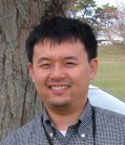
|
Ruipeng Li (beamline staff)
|

|
Kevin Yager (partner user beamline staff)
|
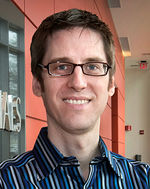
|
Esther Tsai (partner user beamline staff)
|
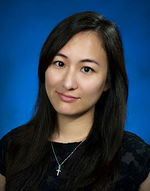
|
Acknowledgements
Publications using data collected at the beamline should include the following in the acknowledgements sections:
- This research used resources of the Center for Functional Nanomaterials and the National Synchrotron Light Source II, which are U.S. DOE Office of Science Facilities, at Brookhaven National Laboratory under Contract No. DE-SC0012704.
Training
Software
- The CMS beamline configuration is stored at: https://github.com/NSLS-II-CMS.
- See Software for a list of software useful in SAXS/WAXS experiments.
